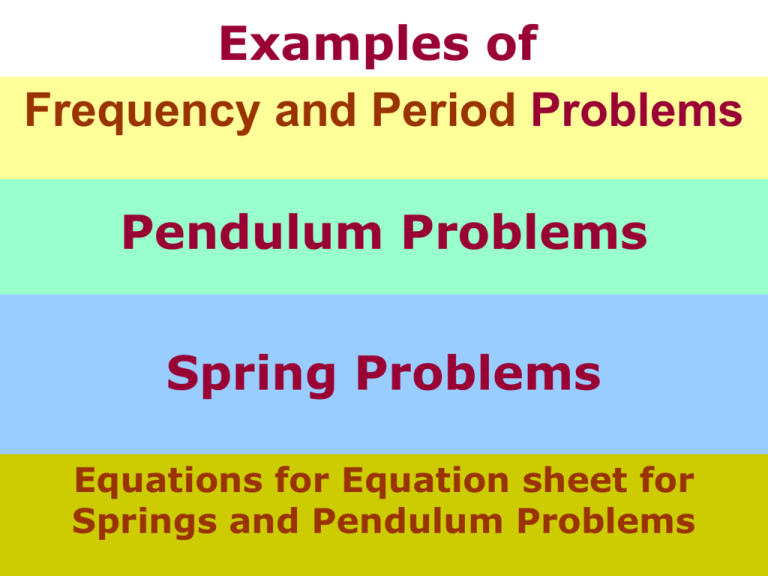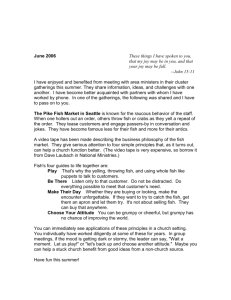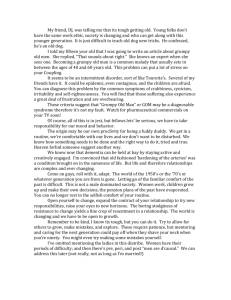Examples of Pendulum and Spring Problems
advertisement

Examples of Frequency and Period Problems Pendulum Problems Spring Problems Equations for Equation sheet for Springs and Pendulum Problems Examples of Period Frequency Problems Frequency and Period Problem (Without Period or Frequency given) Terry Jumps up and down on a trampoline 30 times in 55 seconds. What is the frequency with which he is jumping? 30 times 55 seconds 0.55 Hz Frequency and Period Conversion problem Terry Jumps up and down on a trampoline with a frequency of 1.5 Hz. What is the period of Terry’s jumping? 1.5 Hz 0.67 sec Examples of Pendulum Problems Problem: • At the California Academy of Sciences the length of the pendulum is: 90m = L • The acceleration of gravity at this location is: 9.8 m/s/s = g • What is the Period? T=???? seconds Solution Solve: “Plug and Chug” List: L = 90m g = 9.8 m/s/s T=???? seconds 90 m 9.8 m/s/s 9.18 s2 Choose equation: (3.03 s) (19.0 s) A problem where you Find the period or frequency 1st A pendulum has a length of 3 m and executes 20 complete vibrations in 70 seconds. Find the acceleration of gravity at the location of the pendulum. A pendulum has a length of 3 m and executes 20 complete vibrations in 70 seconds. Find g. 1. f = cycles / seconds = 20 cycles / 70 seconds = 0.286 hz = 0.286 / sec 2. T=1/f = (1 / 0.286) seconds = 3.5 seconds What short cut could I have used? # vibrations # seconds is the time for all the oscillations L = 3m and T= 3.5 seconds Find the acceleration of gravity at the location 3.5 s = 2π√(3/g) 3.5 s = 6.28 √(3/g) Heads up!! If you ÷ by 2π Use (2π ) !! Square both sides 12.25 = 39.43 (3/g) 12.25 = 118.3/g 12.25(g) = 118.3 Divide by 12.25 g = 9.658 m/s/s A problem Where "g" = 9.8 m/s/s is “understood” Know you use g=9.8 m/s/s if: “g” not given or asked for used 9.8 m/s/s Part 1: A simple pendulum has a period of 2.400 seconds where "g" = 9.810 m/s/s. Find the length? Part 2: Find "g" where the period of the same pendulum is 2.410 seconds at a different location. Why are the items green on this problem?? Pendulum is not a variable, why is it marked?? • A simple pendulum has a period of 2.400 seconds where "g" = 9.810 m/s/s. Find the length? • Find "g" where the period of the same pendulum is 2.410 seconds at a different location. 1st find the Length A simple pendulum has a period of 2.400 seconds where "g" = 9.810 m/s/s. T2=4π2 (L/g) • Write equation 2.4002=4 π2 (L/9.810) • Substitute #’s 2.4002= 39.44 (L/9.810)• Square 4 π2 2.4002(9.810) = L • ÷ 39.44 And X 9.810 39.44 L=1.433 m • Answer with label Part 2: Use Length from 1st part of problem Same Pendulum, same length NOW: Find "g" where the period of the pendulum is 2.410 seconds. T2=4π2 (L/g) 2.4102= 4π2(1.433/g) 2.4102=39.44(1.433/g) g 2.4102=39.44 (1.433) g =39.44(1.433)/2.4102 g = 9.73 m/s/s Equation Substitute #’s 4 π2 =39.44 X by “g” ÷ 2.4102 Answer and label Examples of Spring Problems Hooke’s Law graphing Examples of using the graph to find the Slope and tHe vaLue of “k” for springs What is the spring constant for the data graphed below? Δx(m) y2 - y1 Slope = (6,147) k= x2-x1 147N – 49N 6 m – 2m (2,49) (0,0) k= Δx(m) How do I know the Label?? Labels on axes: Rise (N) & Run (m) So: rise/run is N/m !! 98 N 4m k = 24.5 N/m Examples of Spring Problems Using Equations Examples of Hooke’s Law problems Stretch or compress – at rest In anticipation of her first game, Alesia pulls back the handle of a pinball machine a distance of 5.0 cm. The force constant is 200 N/m. How much force must Alesia exert? Examples of Hooke’s Law problems In anticipation of her first game, Alesia pulls back the handle of a pinball machine a distance of 5.0 cm. The force constant is 200 N/m. How much force must Alesia exert? List: Δx = 5.0 cm = .05 m k = 200 N/m Fsp=??? Fsp= k Δx Fsp= 200N/m(0.05 m) Fsp= 10N Equation Substitute #’s Answer with label Example of Oscillation spring Problems Oscillating or bouncing • Bianca stands on a bathroom scale which has a spring constant of 220 N/m. The needle is bouncing from side to side. Bianca’s mass is 180 kg. What is the period of the vibrating needle attached to the spring? Example of Oscillation Spring Problem List: k = 220 N/m m = 180 kg • Bianca stands on a bathroom scale which has a spring constant of 220 N/m. The needle is bouncing from side to side. Bianca’s mass is 180 kg. What is the period of the vibrating needle attached to the spring? T = ?? 0.818 s2 180 kg (0.904 s) 220N/m 5.7 sec Spring Problems Use Both Equations Example of Combination of Hooke’s Law and Oscillation of spring Find k from Hooke’s Law and then use the oscillation equation Autumn, a young 20 kg girl, is playing on a trampoline. The trampoline sinks down 9 cm when she stands in the middle. What is the spring constant? If the trampoline then begins to bounce, what would the frequency of the bounces be? Autumn, a young 20 kg girl, is playing The PLAN: on a trampoline. The trampoline sinks Using Hooke’s Law and Oscillation 1st Find Force of Gravity on mass down 9 cm when she stands in the of spring middle. What is the spring constant? F2gnd= m agk from Hooke’s Law Find If the trampoline then begins to bounce, what would the frequency of the bounces be? List : Fsp= k Δx 3rd use the oscillation equation to find T 4th convert to Frequency m = 20 kg Δx = 9 cm = 0.09 m f = ?? Using Hooke’s Law & Oscillation of spring 1st Find Force of Gravity on mass Autumn, a young 20 kg girl, is playing on a trampoline. The trampoline sinks down 9 cm when she stands in the middle. What is the spring constant? List : m = 20 kg Fg= m ag Δx = 9 cm = 0.09 m Fg= 20kg(-9.8m/s/s) f = ?? Fg= - 196 N Recall From the FBD on the Lab SO. . . FS = + 196 N Example of Combination of Hooke’s Law and Oscillation of spring Autumn, a young 20 kg girl, is playing on a trampoline. The trampoline sinks down 9 cm when she stands in the middle. What is the spring constant? 2nd Find k from Hooke’s Law List : Fsp= k Δx 196 N =k(0.09m) 2180 N/m = k m = 20 kg Δx = 9 cm = 0.09 m Fs= 196 N f= ?? Example of Combination of Hooke’s Law and Oscillation of spring Autumn, a young 20 kg girl, is playing on a trampoline. The trampoline sinks down 9 cm when she stands in the middle. What is the spring constant? 3rd use the oscillation equation to find T If the trampoline then begins to bounce, what would the frequency of the bounces be? List : m = 20 kg Δx = 9 cm = 0.09 m Fs= 196 N k = 2180 N/m 20 kg 2180 N/m T= f = ?? (0.958 s) .00917 s2 .602 sec Example of Combination of Hooke’s Law and Oscillation of spring Autumn, a young 20 kg girl, is playing on a trampoline. The trampoline sinks down 9 cm when she stands in the middle. What is the spring constant? If the trampoline then begins to bounce, what would the frequency of the bounces be? 4th convert to frequency List : m = 20 kg Δx = 9 cm = 0.09 m Fs= 196 N k = 2180 N/m .602 s T = 0.602 sec f = ?? 1.66 Hz Spring Problems 4 part Spring problem Use Fg to find the k value and then use same string with same k to find 2nd mass. If two “Grumpy Old Men” went ice fishing and were comparing their fish with the extension of the same spring, solve the following spring problem: “Grumpy Sam” caught the first fish and magically realized the fish had a mass of 23 kg. When this fish was suspended on the spring, like the one we suspended masses on in lab, the spring stretched so it was 3 cm longer than it was without the fish. What is the spring constant for the spring? “Grumpy Joe” then caught a fish that caused the same spring to extend 5 cm from the length of the empty spring,. What was the mass of “Grumpy Joe’s” fish? The Plan to solve: Example of 4 part Spring problem 1st Use Fg to find the Force on the spring 2nd Use Hooke to find the k value If two “Grumpy Old Men” went ice fishing and were comparing their fish with the extension of the same spring, solve the following spring problem: “Grumpy Sam” caught the first fish and magically realized the fish had a mass of 23 kg. When this fish was suspended on the spring, like the one we suspended masses on in lab, the spring stretched so it was 3 cm longer than it was without the fish. What is the spring constant for the spring? List : 3rd Same spring with same k to find 2nd Force m = 23 kg Fg= ?? Δx = 3 cm = 0.03 m Fsp = ?? 4th Convert weight to mass. Examples of 4 part Spring problem If two “Grumpy Old Men” went ice List : m = 23 kg Fg= Δx = 3 cm = 0.03 m Fsp = fishing and were comparing their fish with the extension of the same spring, solve the following spring problem: “Grumpy Sam” caught the first fish and magically realized the fish had a mass of 23 kg. When this fish was suspended on the spring, like the one we suspended masses on in lab, the spring stretched so it was 3 cm longer than it was without the fish. What is the spring constant for the spring? 1st Use Fg to find the Force on the spring Fg= m ag Fg= 23kg(-9.8m/s/s) - 225 N = - Fs Fg= - 225 N + 225 N = + Fs Examples of 4 part Spring problem If two “Grumpy Old Men” went ice List : m = 23 kg Fg= - 225 N Δx = 3 cm = 0.03 m Fsp = 225 N 2nd use Hooke to find the k value Fsp= k Δx 225 N =k(0.03m) 7500 N/m =k fishing and were comparing their fish with the extension of the same spring, solve the following spring problem: “Grumpy Sam” caught the first fish and magically realized the fish had a mass of 23 kg. When this fish was suspended on the spring, like the one we suspended masses on in lab, the spring stretched so it was 3 cm longer than it was without the fish. What is the spring constant for the spring? “Grumpy Joe’s” Fish Examples of 4 part Spring problem List : NEW FORCE m = ??? kg NEW MASS SAME SPRING!! Fg= ???? N Δx = 5 cm = 0.05 m Fsp = ?? N k = 7500 N/m “Grumpy Joe” then caught a fish that caused the same spring to extend 5 cm from the length of the empty spring,. What was the mass of “Grumpy Joe’s” fish? 3rd same spring with same k to find other Force Fsp= k Δx Fsp = 7500N/m (0.05m) Fsp = 375 N Examples of 4 part Spring problem List : m = ??? kg Fg= -375 N Δx = 5 cm = 0.05 m Fsp = 375 N k = 7500 N/m “Grumpy Joe’s” Fish NEW FORCE NEW MASS SAME SPRING!! “Grumpy Joe” then caught a fish that caused the same spring to extend 5 cm from the length of the empty spring,. What was the mass of “Grumpy Joe’s” fish? 4th convert weight to mass Fg= m ag - 375 N = - Fs -375 N= m(-9.8m/s/s) + 375 N = + Fs m= 38.3 kg Equation Sheet Slides for Springs and Pendulums Period and Frequency-notes • Hertz is unit that means 1/sec • Abbreviated ------- Hz • Mega Hertz –FM radio Page 3 Space #4 • Kilo Hertz – AM radio Period # cycles Hz Sec-1 1/sec # repetitions f # revolutions Frequency Period and Frequency • Hertz is unit that means 1/sec • Abbreviated ------- Hz • Mega Hertz –FM radio Page 3 Space #5 • Kilo Hertz – AM radio Period Hz f Sec-1 1/sec Frequency Use when you know either T or f Oscillations for Pendulums only-Notes Length of the pendulum and gravity determine how fast the pendulum oscillates back and forth. Page 3 Space #6 Period m/s/s m/s2 Scalar-positive!! Hz Sec -1 1/sec All 3 equations are the same, just re-arranged Page 4 #1 Page 4 #2 Springs only page 4 Space #3 Period and Frequency • Hertz is unit that means 1/sec ( Hz) Hooke’s Law for Springs only Springs only





